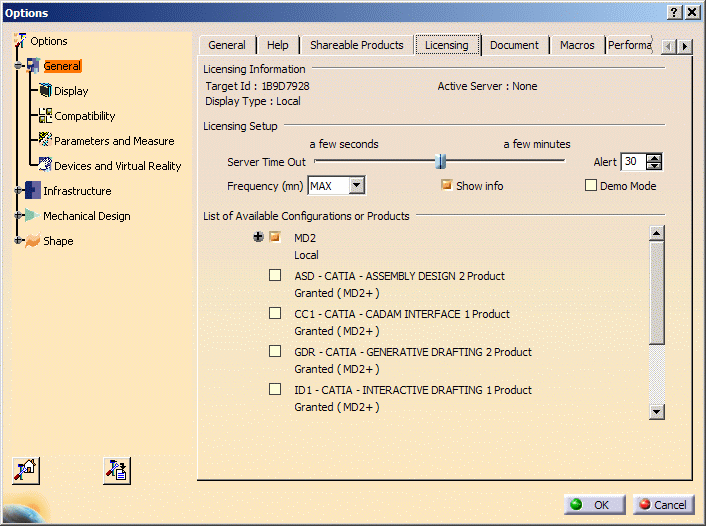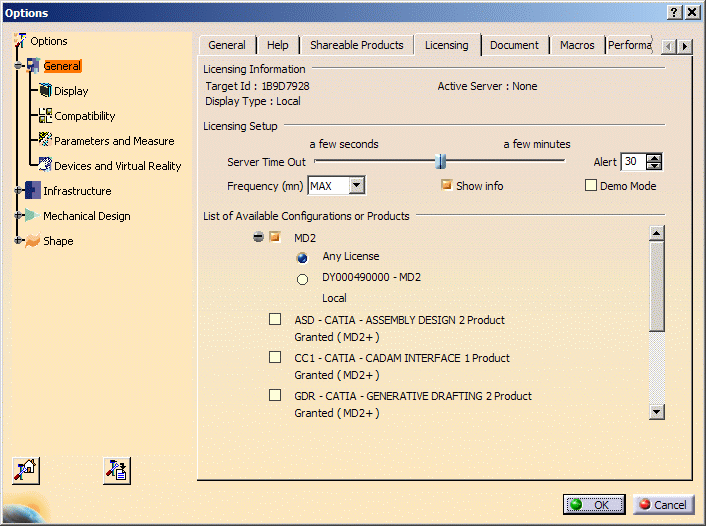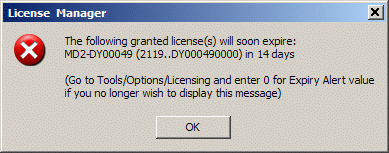The role of the License Manager is to allow you to reserve licenses before using these products. You will not be able to work with any Version 5 products until you have first reserved the corresponding licenses.
If you are using network licensing, selecting this tab contacts any license servers to update the list of available configurations and products.
You must select at least one configuration license.
In our example, it will look like this if you installed the configurations CATIA - Mechanical Design (MD2) and CATIA - Drawing Production (DP2), and imported a nodelock license for the CATIA - Mechanical Design (MD2) configuration:

Licensing Information
- Target id: specifies the target id of your computer
- Display Type: informs you whether you are running on a local
or remote display;
- Local: you are running on a local display and you can work with either nodelock or server licenses
- Remote: you are running on a remote display and you can work with server licenses only.
- Active servers: if you are using network licensing, the list of all active and the number of available license servers is now displayed like this:
The name of the server you are using is displayed in the field opposite. Click the the up and down arrows to display the list of servers available.
If you are using nodelocked licensing only (in other words, if you are not using network licensing), the following is displayed:
Active Server : None
Licensing Setup
- Server Timeout: When a client requests a license from a
license server list, the client is prepared to wait a certain amount of
time for a response from the first license server (the server replies
that the license is available or not available) before contacting another
server. A slider lets you specify approximately the amount of time the
client is prepared to wait for a response from the license server, from a
few seconds to a few minutes.
If you have a high-performance network, and servers that are not heavily loaded, we recommend that you reduce the value: this will allow the client to contact other servers more quickly, instead of waiting too long for a response from the first server.
If you have a low-performance network, or servers that are heavily loaded, we recommend that you increase the value: this will allow the client to wait long enough for a response over a slow network or from heavily loaded servers.
- Frequency (mn): allows you to set the heartbeat duration.
In principle, a license granted by a LUM license server to a V5 session is released when the V5 session stops. The license is also automatically released when a V5 session crashes.
However, it may occur in the event of certain severe crashes or network problems, that the V5 session cannot instruct the license server to release the license, so the license is not released. To prevent the license from being retained endlessly by the license server, there is a specified period of time (referred to as the "heartbeat") after which the license server considers the V5 session to be dead, and releases the license. This heartbeat is communicated to the license server by the V5 session when the license is first requested.
Originally, the value of the heartbeat was set by default to approximately 17 mn, which meant that a license could be incorrectly retained by the license server up to 17 mn, and could not be customized. During this period of time, this license cannot be granted to another user. However, it can still be granted to the same user on the same machine on which the severe crash occurred.
Now, you can set the heartbeat using the Frequency option. The default value is the same as before: approximately 17 mins. This is the maximum value (represented by the value MAX in the list) and cannot be increased. Decreasing the heartbeat value will decrease the maximum period of time during which a license can be inadvertently retained by the license server.
You can set the appropriate value by increments of 1 min. Consequently, the heartbeat can be set to any of the following range of values: 1, 2, 3, 4, 5, 6, 7, 8, 9, 10, 11, 12, 13, 14, 15, 16 and MAX.
The value is stored in the settings, and can be locked if required.
Note: because the V5 session must contact the license server more frequently, decreasing the heartbeat leads to increased network load and to increased license server workload. In particular, before decreasing this value to below 6 minutes, evaluate carefully the impact on license server performance.
Allow save if license server goes down
When a license server or the network goes down, a Version 5 session now enters a special mode giving users the opportunity to save their work before exiting.
To understand the new behavior when a license server goes down, let`s look at what happened in previous releases. Let`s take the example of a concurrent license granted to a V5 session when started. Every heartbeat period (about 17mn), the V5 session checks that the license is still granted to it. It may occur that, for example, the license server or the network are down. In that case, the license check fails.
The session then enters a "countdown" mode. A popup is displayed informing the user that the license check has failed. The user must then save any work in progress. Five checks are performed at one minute intervals. If all checks fail, the session exits.
There were two problems:
- users may not necessarily have understood that any work in progress had to be saved.
- even when a save was launched, the session could be exited while the save was still running.
From now on, the popup message clearly indicates to users that saving open documents is strongly recommended. After the five failed checks, instead of exiting, a new license request is attempted. If it succeeds, the session continues. If this session fails also, the session is set to a special mode in which only saving and exiting commands are available. All menu items and toolbars are grayed out, except the commands Exit, Save, Save As, Save All and Save Management from the File menu. Only the save and exit commands can be launched by using power input.
Notes:
- processes such as batches and macros do not support this mechanism: automatic exit is still performed.
- even if the problem which led to the license check failure is solved, it is impossible to return to the normal mode after the session has been set to the special mode in which only saving and exiting are allowed: no other license request is performed after entering in this mode
- Show Info: check this
option if you want feedback when attempting to reserve a license which is
not available (reserved by another user), or messages about expired
server licenses. The next time you start a
session, the software will inform you who is using the license you are
trying to use. Uncheck this option if you do not want to display this
type of information.
Note that this mechanism, even though managed by the Licensing tab, also applies to shareable product licenses managed by the Shareable Products tab.
- Demo mode: You will be able to work in demo mode if you registered and reserved at least one configuration license, and checked the Demo Mode option. For more information about the demo mode, refer to Running in Demo Mode.
- Alert: use the alert setting if you want to be informed by a message (popup in the interactive application and written in logs for batch application) that a license will soon expire.
License Expiry Date Warnings
Information about license expiry dates is already available via the Nodelock Key Management tool which lists nodelock licenses and the remaining validity duration using a color code:
- green means more than 30 days before expiration
- orange means less than 30 days before expiration
- red means already expired.
Regarding concurrent licenses, LUM tools allow the administrator to manage licenses and in particular to determine license expiry dates.
But neither method provides end users with advanced warning of imminent license expiry.
Setting the License Expiry Alert
The Alert control:
is set by default to 30 days, and is enable by default. This means that if a granted license is going to expire within 30 days, a warning popup will be displayed like this:
The popup is displayed as soon as a license is granted. This means that the popup will appear each time you start a session (because the licensing settings specifying that a nodelock license is granted are read at startup) or when you select a shareable license (because the license is granted immediately).
Note that:
- the maximum value you can set is 90 days
- if you do not want to be warned by a popup when acquiring a license, set the value to 0 to disable the alert
- the tooltip message displayed when pointing at the control indicates the value is between 0 and 90 days
- like any other setting attribute, it can be locked.
The alert is available only for nodelock (and consequently offline) licenses.
If more than one license is about to expire, the popup will display a message like this:
The following granted license(s) will soon expire:
MD2 (2118..R1) in 10 days
GSD (2126..R1) in less than 24 hours
(Go to Tools/Options/Licensing and enter 0 for Expiry Alert value if you no longer wish to display this message)
In the case of batch licensing, the equivalent information is written to the batch log file.
List of Available Configurations/Products
Note that, if you have not previously reserved any licenses, none of the check buttons is checked.
If you are working with a nodelocked license, the license will be reserved by default when you start a session, even if you unchecked the corresponding button.
If you entered a nodelock license during the installation, the corresponding configuration is preselected in the list.
In our example, the MD2 option is checked because we imported a nodelock license for this configuration (CATIA - Mechanical Design (MD2) (DS4D8E940000 - MD2)) during the installation.
The "+" button is displayed next to the license in the list. Clicking this button lets you switch between compact mode (the default) and expanded mode. In compact mode, the license imported is already reserved.
Click the "+" button to switch to expanded mode. In this mode, a sublist is displayed containing the list of all the installed licenses, preceded by the "Any License" option.

- selected configuration licenses forced by the administrator, in alphabetical order
- selected product licenses forced by the administrator, in alphabetical order
- selected configuration licenses not forced by the administrator, in alphabetical order
- selected product licenses not forced by the administrator, in alphabetical order
- non-selected product licenses with the "Granted" status, in alphabetical order
- non-selected configuration licenses available for selection, with the "Not Granted" status, in alphabetical order
- non-selected product licenses available for selection, with the "Not Granted" status, in alphabetical order
- non-selected configuration licenses, not available for selection, with the "No License" status, in alphabetical order
- non-selected product licenses, not available for selection, with the "No License" status, in alphabetical order
- non-selected configuration licenses, not available for selection, locked and prohibited by the administrator, in alphabetical order
- non-selected product licenses, not available for selection, locked and prohibited by the administrator, in alphabetical order.
How To Reserve Licenses
- Any License
- License serial number XXX
- License serial number YYY
- ...
Your administrator instruct you specifically to reserve a specific license with a specific serial number in the list. In this case, check the button for the corresponding license.
You can also reserve a license for an individual product.
For a variety of reasons, (network performance, license availability, ...) you may decide to install several identical configuration licenses on different license servers. Furthermore, these licenses may have identical serial numbers, but they may also have different serial numbers.
If you are interested in using a specific configuration, irrespective of the serial number, and you do not care which server serves the license, check the Any License option. This means that you want to reserve any one of the licenses for that configuration in the list.
In this case, the software reserves by itself one of the available licenses. If the software finds a valid nodelock license on your computer, the nodelock license will be used first. If there is no nodelock license, or the nodelock license is not valid, the software will reserve a network license from the list of license servers.
Note: each license has its own serial number. The same configuration license can exist on several servers but with different, unique serial numbers. Once a serial number is determined (when a license is acquired), it cannot be modified during the same session. This means that if the license server which provides the license using the Any License option becomes unavailable, the session will stop: the license will not be replaced by a license for the same configuration from a different server, because the serial numbers are different.
Server (ip:servername)
where "servername" is the name of the license server.
The status No License appears next to configurations and products which have been installed, but for which you do not have a license. The configuration and product names are grayed out in the list, and the check buttons cannot be checked.
You need to restart your session after reserving configuration and/or product licenses.
Licensing settings are stored in a settings file. The settings active in the License tab depend on what you set the last time you used it.
For background information about locking settings, refer to Locking Settings.
Troubleshooting Messages
You may encounter one of the following messages (the list is not
exhaustive) when using the Licensing Manager:
Environment xxx not set or incorrect. Please set an
environment using the setcatenv commandSet a valid
environment using the setcatenv command. For more information about
customizing environments, refer to Customizing
Your Environment on Windows.
No Configuration/Product AvailableThe path
containing the information required to display the list of
configurations/products, referenced by the CATICPath environment variable,
is incorrect, or the information is incomplete.
There is no suitable license to fulfill the xxx request
You tried to reserve a license when all available licenses are used.
Contact your administrator. See Show License
Info.
You have requested one or more product licenses, but no
configuration license. Click OK and select at least one configuration
license using the License Manager dialog box.You tried to reserve
only a product license. Click OK and select at least one configuration
license using the License Manager.
No License Available for Requested Configuration(s)
Click OK and select at least one valid configuration license using the
Licensing tab.
Not All Licenses AvailableContact your administrator.
![]()


